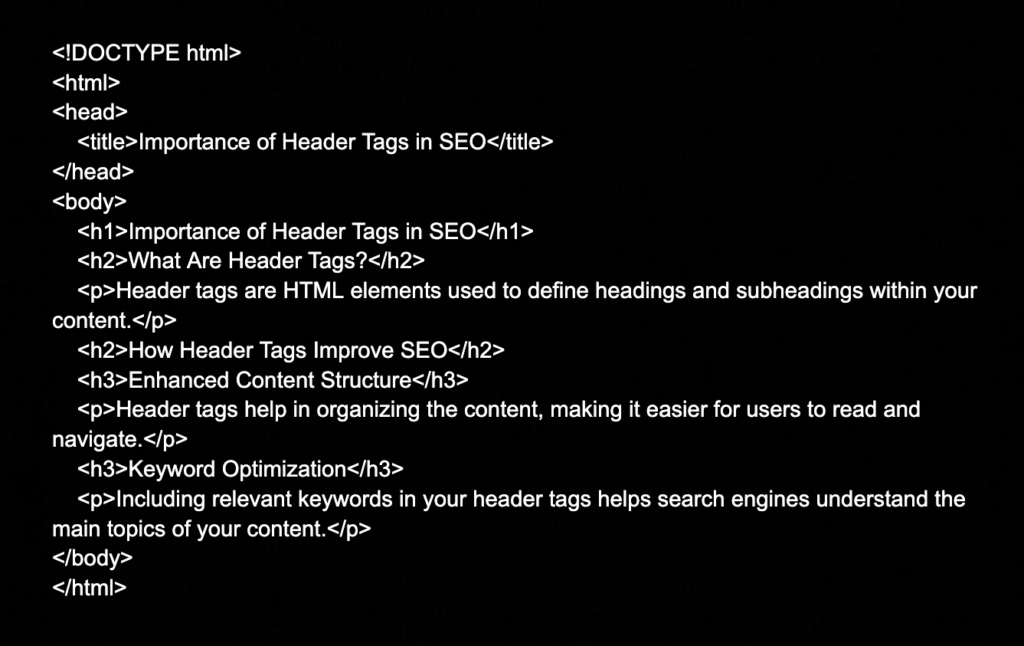
The Importance of Header Tags (H1, H2, H3, H4, H5, H6) in SEO
Header tags are fundamental elements that can significantly influence how your content is perceived by both users and search engines. Understanding and utilizing header tags effectively can improve your website’s readability, accessibility, and search engine ranking. In this comprehensive guide, we’ll explore the importance of header tags in SEO, best practices for their use, and how they can enhance your content’s overall performance.
What Are Header Tags?
Header tags (H1, H2, H3, etc.) are HTML elements used to define headings and subheadings within your web content. They create a hierarchical structure that helps organize the content, making it easier for both users and search engines to understand.
Example of Header Tag Usage

How Header Tags Improve SEO
Enhanced Content Structure
Header tags provide a clear structure to your content, breaking it down into manageable sections and subsections. This not only helps readers quickly find the information they need but also makes it easier for search engines to crawl and index your content.
– H1 Tag: The H1 tag is used for the main title of the page and should include the primary keyword. It sets the context for the entire page.
– H2 Tags: These are used for main section titles and should include secondary keywords. They help in dividing the content into major sections.
– H3 Tags: These are used for subsections under H2 tags and can include more specific keywords. They help in further breaking down the content.
Keyword Optimization
Using header tags strategically allows you to incorporate relevant keywords throughout your content. This practice, known as keyword optimization, signals to search engines the key topics and themes of your page.
– Primary Keywords: Should appear in the H1 tag.
– Secondary Keywords: Should be included in H2 tags.
– Long-Tail Keywords: Can be used in H3 and other lower-level tags.
Improved Crawlability and Indexing
Properly structured header tags make it easier for search engines to crawl and index your content. This enhances your website’s visibility in search results and improves the chances of ranking higher for relevant queries.
– XML Sitemap: Ensure your site has an XML sitemap that includes all important pages.
– Internal Linking: Use header tags to guide internal linking strategies, helping search engines understand the relationship between different pages on your site.
Benefits of Header Tags for User Experience
Easier Navigation
Header tags act as signposts that guide users through your content. Clear and descriptive headers make it easier for readers to navigate and find the information they need.
Improved Readability
Well-structured content with appropriate header tags is more readable. Users can quickly scan the headings to get an overview of the content and decide which sections to read in detail.
Accessibility for All Users
Header tags improve the accessibility of your content. Screen readers and other assistive technologies use header tags to interpret the structure of a webpage, making it easier for visually impaired users to navigate.
– Screen Readers: Use header tags to navigate and understand the content hierarchy.
– Keyboard Navigation: Helps users who rely on keyboard shortcuts to jump between sections.
Best Practices for Using Header Tags
Proper Hierarchy
Maintaining a clear and logical hierarchy in your header tags is crucial for both SEO and user experience. Avoid skipping levels and ensure each header tag accurately represents the content that follows.
– H1: Main title of the page.
– H2: Main sections of the content.
– H3: Subsections under H2.
– H4-H6: Additional levels of subsections as needed.
Relevant and Descriptive Headers
Headers should be descriptive and relevant to the content they introduce. This not only helps with SEO but also provides clarity to readers.
– Use Keywords Naturally: Incorporate relevant keywords without forcing them.
– Clear Descriptions: Ensure headers accurately describe the content that follows.
Optimal Length and Format
Keep header tags concise yet informative. Overly long headers can be truncated in search results, while very short headers may lack the necessary detail.
– Title Length: Aim for 50-60 characters for H1 tags.
– Concise Headers: Keep H2 and H3 tags short and to the point.
Common Mistakes to Avoid with Header Tags
Keyword Stuffing
Overloading header tags with keywords can lead to a negative user experience and potential penalties from search engines. Focus on natural keyword integration.
Multiple H1 Tags
Having more than one H1 tag can confuse search engines and dilute the focus of your content. Stick to a single H1 tag per page.
Skipping Header Levels
Skipping header levels (e.g., jumping from H1 to H3) disrupts the logical flow of your content. Ensure a clear, hierarchical structure.
Inconsistent Header Usage
Inconsistent or improper use of header tags can confuse both users and search engines. Maintain uniformity and logical progression in your headers.
Future Trends in Header Tags and SEO
Voice Search Optimization
As voice search becomes more prevalent, structuring content with header tags becomes even more important. Voice queries often involve questions and long-tail keywords, which can be effectively targeted using header tags.
AI and Machine Learning
Search engines are increasingly using AI and machine learning to understand content. Proper use of header tags can help these technologies better interpret the context and relevance of your content.
Mobile-First Indexing
With the shift towards mobile-first indexing, having a clear and concise header tag structure is essential for ensuring your content is easily navigable on mobile devices.
Core Web Vitals
Google’s Core Web Vitals emphasize user experience metrics. Proper header tag usage contributes to a better user experience, which can positively impact these metrics.
Conclusion
Header tags are a vital component of SEO that can enhance your website’s structure, readability, and search engine performance. By following best practices and avoiding common mistakes, you can leverage header tags to improve both user experience and SEO outcomes. Lastly, staying updated with future trends helps to ensure that your content remains optimized and competitive.